| |
|
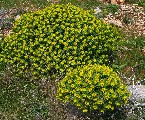 | |
| MaltaWildPlants.com by Stephen Mifsud |

|
| |
|
|
 |  |  |  |
| External Links: |
|
Xanthium strumarium (Rough Cocklebur) |

Xanthium strumarium (ASTERACEAE.)
Images for this profile are taken from the Maltese Islands after year 2000. |
|
| Nomenclature |
Species name : | Xanthium strumarium L. | Authority : | Carl von Linne, Sweden, (1707 - 1778) | Synonyms :
(basionym or principal syn.) |
|
Plant Family : | Asteraceae Bercht. & J.Presl (= Compositae )
(Daisy or Sunflower Family) | English name(s) : | Rough Cocklebur, Common Cocklebur, Burweed | Maltese name(s) : | Maltese name not known | Status for Malta : | Naturalised Alien. Species that was introduced in Malta after year 1492 (Columbus' discovery of the New World)
and spreads and integrates to form established, non-invasive populations.
Species may become become invasive if it widespreads rapidly. | Name Derivation : |
Xanthium: An old name applied by Dioscorides (40 - 90 AD) to a cockbur plant where a yellow hair dye was extracted. (Greek origin ); 2 = Yellow or amber (Greek).
strumarium: swelling or tumour-like structure, with reference to the swollen ovoid fruit. (Latin origin ); 2 = Swelling, tumor-like; in reference to the swollen fruit (Latin).
| Remarks : | |
|
| Morphology and structure |
PLANT STRUCTURE: |
Character | Growth Form | Branching | Surface |
Description | | | |
General
Picture |  |  | 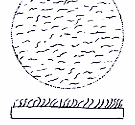 |
|
LEAVES: |
Character | Arrangement | Attachment | Venation |
Description | | | |
General
Picture |  | 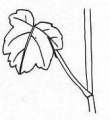 |  |
| |
Character | Leaf Shape | Leaf Margin | Remarks |
Description | | | Long Petiole Leaf stalk is more than the length of the supporting leaf. |
General
Picture | 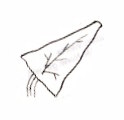 |  |  |
|
FLOWERS: |
Character | Colour | Basic Flower Type | No. of Petals | No. of Sepals |
Description | Green | Male: Rather inconspicuous flower heads lacking radiating petals (=ray florets) and only bear tiny, disc-florets packed on a common receptacle. Such flower-heads normally have a cylindrical, cushion-like or discoid shape.
Female: Disc florets very rudimentary, consisting only of hair like styles that are barely visible to the naked eye. | 0 Male and female flowers have no petals. | Female: 5 + 1 Female flowers have 5 free sepals at the very base of the flower and a single compound involucral structure. |
General
Picture | |  |  |  |
| |
Character | Inflorescence | Description | Ovary | Stamens |
Description | Loose axillary racemes Several flowers in a loose raceme growing from leaf axils. Male capitula above female flowers. | Male capitulum is sub-spherical holding many florets which basically consists of staminal columns only. The female part have a specialized oval closed involucral structure with many hooks and 2 pointed hollowed beaks from which the hair like stigma of 2 flowers projects out. | | 5 free stamens |
General
Picture |  |  | 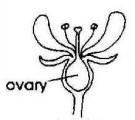 |  |
| |
Character | Scent | Average Flower Size | Pollen Colour | Other Notes |
Description | None | Male: 10mm
Female: 20mm. | Pale Yellow | - |
|
SEEDS: |
Character | No. Per Fruit | Shape | Size | Colour |
Description | 2 | Oval and flattened Flattened, oval seeds resembling shape and size of sunflower seeds. | 12 - 15 mm | Black |
General
Picture |  |  |  |  |
|
FRUIT AND OTHER BOTANICAL DATA: |
Character | Fruit Type | Colour of Fruit | Subterranean Parts | Other Notes |
Description | Achenes without Pappus enclosed by a involucral wall. 2 achenes without Pappus held inside an oblong-ovate enclosed involucral wall with many radiating hooks. | Brown (sometimes yellow-brown). | | Scent Plant has a particular semi-aromatic smell. |
General
Picture |  |  |  |  |
|
|
| Plant description and characters | |
Life Cycle: | Annual. |
Growth Form: | THEROPHYTE (annual plants, herbaceous) |
Habitat: | Dry valley beds, water catchment areas, reservoirs. |
Frequency: | Scarce |
Localities in Malta: | Densely populated at the bed of the Chadwick Lakes watercourse. |
Plant Height: | 30-120cm. |
| Jul-Oct |
Protection in Malta: | Not legally protected till the last update of this website (2/Mar/2022) |
Red List 1989: | Not listed in the Red Data Book of the Maltese Islands |
Poison: | |
Erect, herbaceous plant, much branched, about 1 metre in height, producing many large leaves at the end of Spring. The stem is usually green, pitted with short, purple-maroon streaks or completely maroon in few specimens. Many specimens have stems and leaf petioles with stiff short hair.
Leaves have a long petiole that is longer than the lamina. The length of the leaves vary with maturity but basal leaves can reach up to 16cm in length and 14cm in width. The shape of the leaf is more or less broadly triangular with a V-notched or heart shaped (cordate) base. Mature leaves further produce 3 to 4 lobes. The lamina have prominent, bulging veins and its outline is coarsely serrated.
The plant is monoecious; producing male and female flowers separately on the same plant. Both flowers are inconspicous and borne in a common cluster growing at the leaf axils where the male are located above the female flowers.
The male pseudanthium (composite inflorescence reempling a single flower) is semi-spherical with numerous male florets where the ones at the base develop first and maturity gradually progresses to the flowers at the top (and centre). Male florets are without petals and lack a pistil. They consist of 5 stamens where their white filaments are fused together as a single column, while the brown anthers are free and erect. They produce pale yellow pollen.
The female flower is quite different. There are 2 florets enclosed in a specialized compound structure called the involucrum. This is oval, bright green and covered with many linear projections about 2-3mm long terminated by a tiny, rigid hook. The style of each floret pair protrudes out from this enclosed structure through a tiny apical pore. Each pore is located at the tip of two conical pointed horns at the upper part of the involucrum. These 2 horns are about 2-3mm long. The styles are hair-thin and inconspicuous but the involucral structure is distinctive and conspicuous due its peculiar shape. The female florets have no corolla or stamens.
The involucral structure develops into the fruit each holding only two seeds (achenes). In many Asteracea one ovule (=>seed) is usally aborted giving only once achene per foret. These seeds have a flattened oval shape (like sunflower seeds) and a completely black seed coat.
The hard fruit do not split open to expose the seeds outside. The whole structure attaches itself securely via its hooks with passing animals (job done particularly well with clothes too) and carried away until the carrier notices it and drops it away. They can be carried by water currents too since the woody fruit will float. Water causes the fruit wall to soften and deteriorate, and so, the seeds inside are free to germinate when environmental conditions are favourable.
|
|
| Information, uses and other details |
Distribution and Nativity
The plant is distributed throughout many places around the world as it can be seen in the list below: [WWW-26]
ASIA-TEMPERATE
Western Asia: Afghanistan, Iran, Iraq, Turkey
Caucasus: Armenia, Azerbaijan, Georgia
Siberia: Russian Federation - Eastern Siberia, Western Siberia
Soviet Middle Asia: Kazakhstan, Kyrgyzstan, Tajikistan, Turkmenistan, Uzbekistan
Soviet Far East: Russian Federation - Primorye, Sakhalin
Central Asia: China, Mongolia
Eastern Asia: Japan, Korea
EUROPE
Middle Europe: Austria, Czechoslovakia, Germany, Hungary, Poland, Switzerland
East Europe: Belarus, Moldova, Russian Federation - European part, Ukraine (incl. Krym)
Southeastern Europe: Albania, Bulgaria, Greece (incl. Crete), Italy (incl. Sardinia, Sicily), Romania, Yugoslavia
Southwestern Europe: France (incl. Corsica), Spain (incl. Baleares)
NORTHERN AMERICA
Eastern Canada: Canada - Ontario, Quebec
Western Canada: Canada - Alberta, British Columbia, Manitoba, Saskatchewan
Northeastern U.S.A.: United States - Connecticut, Indiana, Maine (s.), Massachusetts, Michigan, New Hampshire, New Jersey, New York, Ohio, Pennsylvania, Rhode Island, Vermont, West Virginia
North-Central U.S.A.: United States - Illinois, Iowa, Kansas, Minnesota, Missouri, Nebraska, North Dakota, Oklahoma, South Dakota, Wisconsin
Northwestern U.S.A.: United States - Colorado, Idaho, Montana, Oregon, Washington, Wyoming
Southeastern U.S.A.: United States - Alabama, Arkansas, Delaware, Florida, Georgia, Kentucky, Louisiana, Maryland, Mississippi, North Carolina, South Carolina, Tennessee, Virginia
South-Central U.S.A.: United States - New Mexico, Texas
Southwestern U.S.A.: United States - Arizona, California, Nevada, Utah Mexico
SOUTHERN AMERICA
Caribbean: Antigua, Bahamas, Cuba, Dominica, Hispaniola, Jamaica, Martinique, Puerto Rico, St. Kitts and Nevis - Nevis
Worldwide weed, naturalized in Africa, Asia, Australia, New Zealand, Central America, South America, Canary Is., Madeira, Azores, Melanesia, Polynesia, & Hawaii [WWW-26] . The genus Xanthium includes 25 species, all of American origin. The origin of X. strumarium is North America [WWW-114]
Declared as a weed and its herbicide resistance
X. strumarium is listed as noxious weed for: Iowa, Minnesota, New South Wales, Western Australia, Tasmaina, Northen Territory (Aust) [WWW-26] . It was introduced in India and spread like a weed. It commonly grows in waste places and along river banks in warmer parts [WWW-114]
Studies in US have shown that it has developed herbicide resistance as indicated in this table {Click here} [WWW-29]
Xanthium strumarium Subspecies
X. strumarium ssp italicum is aromatic, whilst X. strumarium ssp strumarium is not. Introgressive hybrid populations between these two sub-species are found and are very variable in appearance. [WWW-27]
Toxicity
Reports state that Xanthium strumarium is poisonous to mammals. Most members of Xanthium genus are toxic to grazing animals and are usually avoided by them [222] . The seed also contains toxins [222] .
The plant is rough to the touch and causes itching from the hairs or dust with which it is covered. The burs, if ingested, cause mechanical irritation of the mouth. A weeping eczema from handling the plant has been reported, as has dermatitis in men working among the plants. Patch tests carried out using the leaves of this species crushed in a small quantity of normal saline elicited positive reactions in 7 of 24 contact dermatitis patients tested in New Delhi, India. Cross-reactions to Parthenium hysterophorus were not observed. [WWW-27]
Positive patch test reactions to the oleoresin from this species were observed in 21 from 55 patients with the photosensitivity dermatitis and actinic reticuloid syndrome. Several potentially allergenic xanthanolides have been reported from this species. [WWW-27]
The toxic glycoside carboxyatractyloside is found in the seeds and the cotyledons of seedlings. Livestock are most commonly poisoned after ingesting the cotyledons (seed leaves) of young seedlings [WWW-24, WWW-86] . The toxin quickly dissipates as the seedlings grow. Cattle, horses, and swine are often poisoned and die after ingesting this plant. This plant can produce allergic contact dermatitis in susceptible humans. [WWW-86] The plant has been reported as fatal to cattle and pigs. [WWW-114] and rodents [WWW-24]
FDA database has 113 documents that indicates the toxicity of 'cocklebur' and 102 documents that 'Xanthium strumarium' has some toxic effect to mammals.
Symptoms of cocklebur poisoning includes Loss of appetite, vomiting, weakness, ataxia, spasms, in severe cases, death. [WWW-86] A more detailed study concludes that Carboxyatractyloside poisoning causes multiple organ dysfunction and can be fatal. Coagulation abnormalities, hyponatraemia, marked hypoglycaemia, icterus and hepatic and renal failure are signs of a poor prognosis. No antidote is available and supportive therapy is the mainstay of treatment. [341]
Cocklebur toxicosis in cattle associated with the consumption of mature Xanthium strumarium
Cockleburs (Xanthium spp.) are herbaceous annuals with worldwide distribution. Toxicoses are usually associated with the consumption of the seedlings in the cotyledon stage, which contain a high concentration of the toxic principle, carboxyatractyloside. The seeds are also known to contain the toxin, but it has long been assumed that the spiny capsule would deter their consumption. Six of 70 yearling calves died while being fed round bale hay composed predominantly of foxtail and mature cocklebur plants with burs. Clinical signs ranged from acute death to hyperexcitability, blindness, tense musculature, and spastic gaits with heads held high and ears erect. Some symptomatic calves would stumble, fall to lateral recumbency, convulse, and later recover. Overall, the herd was very uneasy. Prominent gross lesions were ascites and a firm, pale liver with a mottled hemorrhagic pattern on cut surface. The rumen contained numerous intact burs and well-ruminated grass. Histological examination of the liver revealed marked centrolobular degeneration and necrosis with associated hemorrhage and congestion. Brain lesions were present. Plant and tissue samples were analyzed for carboxyatractyloside with various results. Samples of rumen contents, urine, and burs contained 100-200 ppm, 0.1-0.05 ppm, and 0.1 ppm, respectively. Based on the history, clinical signs, pathological lesions, and chemical analyses, cocklebur toxicosis associated with consumption of mature Xanthium strumarium in hay was confirmed. [342]
Cocklebur (Xanthium strumarium, L. var. strumarium) intoxication in swine: review and redefinition of the toxic principle.
Cocklebur (Xanthium strumarium) fed to feeder pigs was associated with acute to subacute hepatotoxicosis. Cotyledonary seedings fed at 0.75% to 3% of body weight or ground bur fed at 20% to 30% of the ration caused acute depression, convulsions, and death. Principle gross lesions were marked serofibrinous ascites, edema of the gallbladder wall, and lobular accentuation of the liver. Acute to subacute centrilobular hepatic necrosis was present microscopically. The previously reported toxic principle, hydroquinone, was not recovered from the plant or bur of X. strumarium. Authentic hydroquinone administered orally failed to produce lesions typical of cocklebur intoxication but did produce marked hyperglycemia. Carboxyatractyloside recovered from the aqueous extract of X. strumarium and authentic carboxyatractyloside, when fed to pigs, caused signs and lesions typical of cocklebur intoxication. Marked hypoglycemia and elevated serum glutamic oxaloacetic transaminase and serum isocitric dehydrogenase concentrations occurred in pigs with acute hepatic necrosis that had received either cocklebur seedlings, ground bur or carboxyatractyloside [344]
List of Medicinal Properties
Xanthium strumarium is reported to have several medicinal properties and was used to treat the following condition or medicinal properties:
[WWW-66]
| Abrasion |
an abraded area where the skin is torn or worn off [WWW-32] |
| Abscess |
symptom consisting of a localized collection of pus [WWW-32] |
| Ache(Head) |
Sensation of pain in the head [WWW-32] |
| Adenopathy |
a glandular disease or enlargement of glandular tissue [WWW-32] |
| Alterative |
tending to cure or restore to health [WWW-32] |
| Anodyne |
capable of relieving pain [WWW-32] |
| Arthritis |
inflammation of a joint or joints [WWW-32] |
| Asthma |
respiratory disorder characterized by wheezing; usually of allergic origin [WWW-32] |
| Astringent |
a drug that causes contraction of body tissues and canals [WWW-32] |
| Bactericide |
any drug that destroys bacteria or inhibits their growth [WWW-32] |
| Bladder problems |
|
| Boil |
a painful sore with a hard pus-filled core [WWW-32] |
| CNS depressant |
a drug that reduces excitability and calms a person [WWW-32] |
| Cancer |
used in the treatment of cancer [WWW-32] |
| Cold |
used to treat colds [WWW-32] |
| Depurative |
Purifying the blood or the humors; depuratory [WWW-32] |
| Diuretic |
any substance that tends to increase the flow of urine [WWW-32] |
| Eczema |
generic term for inflammatory conditions of the skin; particularly with vesiculation in the acute stages [WWW-32] |
| Emollient |
having a softening or soothing effect especially to the skin [WWW-32] |
| Erysipelas |
an acute streptococcal infection characterized by deep-red inflammation of the skin and mucous membranes [WWW-32] |
| Febrifuge |
any medicine that lowers body temperature to prevent or alleviate fever [WWW-32] |
| Goiter |
abnormally enlarged thyroid gland; can result from under-production or over-production of hormone or from a deficiency of iodine in the diet [WWW-32] |
| Hemicrania |
a severe recurring vascular headache; occur more frequently in women than men [WWW-32] |
| Hemostat |
a surgical instrument that stops bleeding by clamping the blood vessel [WWW-32] |
| Herpes |
viral diseases causing eruptions of the skin or mucous membrane [WWW-32] |
| Hyperglycemia |
abnormally high blood sugar usually associated with diabetes [WWW-32] |
| Infection |
Helps to prevent the transmission of infectious disease [WWW-32] |
| Inflammation |
Treats inflammation - A morbid condition of any part of the body, consisting in congestion of the blood vessels, with obstruction of the blood current, and growth of morbid tissue. It is manifested outwardly by redness and
swelling, attended with heat and pain.
[WWW-32] |
| Kidney problems |
|
| Laxative |
stimulating evacuation of feaces
[WWW-32] |
| Leprosy |
Df_ [WWW-32] |
| Leucorrhea |
chronic granulomatous communicable disease occurring in tropical and subtropical regions; characterized by inflamed nodules beneath the skin and wasting of body parts; caused by the bacillus Mycobacterium leprae [WWW-32] |
| Lip problems |
|
| Malaria |
an infective disease caused by sporozoan parasites that are transmitted through the bite of an infected Anopheles mosquito; marked by paroxysms of chills and fever [WWW-32] |
| Parturition |
aids the process of giving birth [WWW-32] |
| Preventitive |
Prevents disease to be transmitted |
| Pruritis |
Itching. Pruritis can result from drug reaction, food allergy, kidney or liver disease, cancers, parasites, aging or dry skin, contact skin reaction, such as poison ivy, and for unknown reasons. [WWW-32] |
| Rabies |
an acute viral disease of the nervous system of warm-blooded animals (usually transmitted by the bite of a rabid animal); rabies is fatal if the virus reaches the brain [WWW-32] |
| Refrigerant |
That which makes to be cool or cold; specifically, a medicine or an application for allaying fever, or the symptoms of
fever [WWW-32] |
| Rheumatism |
any painful disorder of the joints or muscles or connective tissues
[WWW-32] |
| Rhinitis |
an inflammation of the mucous membrane lining the nose (usually associated with nasal discharge) [WWW-32] |
| Scrofula |
a form of tuberculosis characterized by swellings of the lymphatic glands [WWW-32] |
| Sedative |
A remedy which allays irritability and irritation, and
irritative activity or pain [WWW-32] |
| Shingles |
A kind of herpes ({Herpes zoster}) which spreads half way around the body like a girdle, and is usually attended with violent neuralgic pain.
[WWW-32] |
| Sialogogue |
An agent which promotes the flow of saliva.
[WWW-32] |
| Sinusitis |
inflammation of one of the paranasal sinuses [WWW-32] |
| Smallpox |
a highly contagious viral disease characterized by fever and weakness and skin eruption with pustules that form scabs that slough off leaving scars [WWW-32] |
| Struma |
a form of tuberculosis characterized by swellings of the lymphatic glands [WWW-32] |
| Styptic |
tending to check bleeding by contracting the tissues or blood vessels [WWW-32] |
| Sudorific |
inducing perspiration [WWW-32] |
| Swelling |
|
| Syphilis |
a common venereal disease caused by the Treponema pallidum spirochete; symptoms change through progressive stages; can be congenital (transmitted through the placenta) [WWW-32] |
| Tea |
Used as a herbal tea |
| Tonic |
a medicine that strengthens and invigorates [WWW-32] |
| Tubercle |
a protuberance on a bone especially for attachment of a muscle or ligament [WWW-32] |
| Tumor |
an abnormal new mass of tissue that serves no purpose [WWW-32] |
| Tumor (Nose) |
Used to treat tumors specifically in the nose [WWW-32] |
| Urogenital problems |
of or relating to the urinary and reproductive systems [WWW-32] |
| Wound |
Used to improve wound healing |
Medicinal Actions and Uses
The leaves and root are anodyne, antirheumatic, appetizer, diaphoretic, diuretic, emollient, laxative and sedative [61, 147, 178, 222] . The plant is considered to be useful in treating long-standing cases of malaria [240] and is used as an adulterant for Datura stramonium [61] . An infusion of the plant has been used in the treatment of rheumatism, diseased kidneys and tuberculosis [257] . It has also been used as a liniment on the armpits to reduce perspiration [257] .
The fruits are anodyne, antibacterial, antifungal, antirheumatic and antispasmodic [238] . They are used internally in the treatment of allergic rhinitis, sinusitis, catarrh, rheumatism, rheumatoid arthritis, constipation, diarrhoea, lumbago, leprosy and pruritis [238, 257] . They are also used externally to treat pruritis [238] . The fruits are harvested when ripe and dried for later use [238] .
The root is a bitter tonic and febrifuge [240] . It has historically been used in the treatment of scrofulous tumours [222] . A decoction of the root has been used in the treatment of high fevers and to help a woman expel the afterbirth [257] .
A decoction of the seeds has been used in the treatment of bladder complaints [257] . A poultice of the powdered seed has been applied as a salve on open sores [257] .
A valuable and sure specific in the treatment of hydrophobia. An active styptic, local and general. Fluid extract, 1 to 2 drachms. 10 grains of the powdered plant, four times daily.
In many parts of India, it is known as adhasisi (in English adhasisi means hemicrania) as this weed is used for the treatment of this common disease. [WWW-114]
The whole plant, specially root and fruit, is used as medicine. According to Ayurveda, X. strumarium is cooling, laxative, fattening, anthelmintic, alexiteric, tonic, digestive, antipyretic, and improves appetite, voice, complexion, and memory. It cures leucoderma, biliousness, poisonous bites of insects, epilepsy, salivation and fever. The plant of Xanthium yields xanthinin which acts as a plant growth regulator. Antibacterial activity of xanthinin has also been reported. Seed yields a semi-drying edible oil (30-35%) which resembles sunflower oil and used in bladder infection, herpes, and erysipelas. [WWW-114]
During winter season, when the Kuthua herb (Xanthium strumarium) is in flowering and fruiting stage, the healers collect the green spiny fruits and convert it in this paste to make it more potential against migraine. The juice of leaves is also applied and used as eye tonic. It is considered good to prevent the problem of Motiabind (Cataract). In case of conjuctivitis, the juice is applied externally on eyelids in order to provide cooling effect of eyes. [WWW-03]
In Sarguja region of India, X. strumarium is locally known as Kuthua. The Traditional medicinal uses of leaves of Xanthium against herpes is well documented in reference literatures. Every year in winter season, this herb is severly affected by the fungal disease powdery mildew where one report states that the plant diseased with this fungus is more effective to treat herpes. [WWW-03]
The extract of X. strumarium showed an abnormality with V. cholerae, where the inhibition exceeded the control with established antibiotics [343]
Medicinal uses according to the Physiomedical Dispensatory (by William Cook (1869)
The leaves of this ungainly-looking weed are stimulant relaxants, bitterish, and moderately diffusive in action. The profession has scarcely paid any attention to them; but they are among the truly valuable diffusive nervines, ami deserve careful consideration. An infusion of an ounce to a quart of hot water makes a mild diaphoretic that will be found of decided value in colic, restlessness, painful menstruation, and even extreme forms of nervousness and actual hysteria. Such an infusion may also be used in measles, and combined with asclepias in typhoid and erysipelas; in which maladies it aids a full outward circulation, and greatly relieves the nervous irritability. Cold preparations are equally valuable in nervous affections, and exert a mild tonic impression. From my own use of these leaves, confirmed by the experience of Drs. Tyrrell, Overholt, and others, I feel justified in urging this plant upon the notice of the profession, as one that promises to be a peculiarly valuable nervine. [WWW-18]
Medicinal uses according to the Eclectic Materia Medica, Pharmacology and Therapeutics (by Harvey Wickes Felter, M.D., 1922.)
Preparation: Fluidextract of Xanthium Strumarium. Dose, 5 to 60 drops.
Action and Therapy: This agent acts much like clotbur, and has been used with advantage in painful urination, with scalding, and marked sensitiveness of the urethra and bladder, with frequent micturition. It is also said to be of service in hemorrhages, as passive hemorrhage from the bowels and the epistaxis of purpura hemorrhagica. For the last-named disorders it is probably of little value, though it should be tried where other means are unavailing.
Medicinal uses according to the American Journal of Pharmacy. (by editor John M. Maisch, M.D. - Vol. 56, 1884.)
The writer extracted the bruised dried fruit, 195.21 grams, with benzin and obtained 29 grams of a yellowish, non-drying fixed oil having the specific gravity .900 and a peculiar odor somewhat resembling that of freshly extracted flaxseed oil; from the soap prepared with it, oleic acid was obtained, and glycerin was found in the mother liquor of the soap.
With strong alcohol a resinous extract was obtained. The portion soluble in diluted acetic acid gave precipitates with potassio-mercurio iodide, with iodine and with tannin, but not with picric acid; ferric chloride produced a green color, and sugar followed by a drop of sulphuric acid caused a yellowish color slowly changing to carmine and to bright violet red. Ether extracted from the acid solution the principle giving these reactions; but the small quantity subsequently taken up by ether from the same solution rendered alkaline by potassa, did not give these reactions.
Of the resinous substance left after treatment with acidulated water, 4 grams were given to a small dog, producing no visible effects. This substance was freely soluble in ether and alcohol and slightly soluble in potassa and ammonia; ferric chloride added to the alcoholic solution gave a deep green color probably due to a little tannin.
The principle obtained above, though probably not pure, the author thinks may be different from the xanthostrumarin of Zander ("Amer. Jour. Phar.," 1881, p. 271), the latter being precipitated with picric-acid and not precipitated with tannin.
Cultivation details
Requires a sunny position, succeeding in most soils. Prefers a poor dry soil [238] .
Hardy to about -15° C [238] . Plants often self sow and in some parts of the world have become noxious weeds [238]. Propagation by seed: sow spring or autumn in situ [238] . The seed requires plenty of moisture in order to germinate
Edible Uses
Leaves and young plants - cooked [2, 105, 177] . They must be thoroughly boiled and then washed [179] . Caution is advised, the plant is probably poisonous [218].
Seed - raw or cooked [212]. The seed can be ground into a powder and mixed with flour for making bread, cakes etc [105, 257] . The seed contains about 36.7% protein, 38.6% fat, 5.2% ash [179] . It also contains a glycoside [179] and is probably poisonous.
Other Uses
The dried leaves are a source of tannin [145] .
A yellow dye is obtained from the leaves [178] .
The seed powder has been used as a blue body paint [257] .
The dried plant repels weevils from stored wheat grain [178] .
Cake can be used as manure whereas shell can be used as activated carbon [WWW-114]
Caffeic acid as active principle from the fruit of Xanthium strumarium to lower plasma glucose in diabetic rats.
The antihyperglycemic effect of caffeic acid, one of the phenolic compounds contained in the fruit of Xanthium strumarium, was investigated. After an intravenous injection of caffeic acid into diabetic rats of both streptozotocin-induced and insulin-resistant models, a dose-dependent decrease of plasma glucose was observed. However, a similar effect was not produced in normal rats. An insulin-independent action of caffeic acid can thus be considered. Otherwise, this compound reduced the elevation of plasma glucose level in insulin-resistant rats receiving a glucose challenge test. Also, glucose uptake into the isolated adipocytes was raised by caffeic acid in a concentration-dependent manner. Increase of glucose utilization by caffeic acid seems to be responsible for the lowering of plasma glucose. [340]
Personal Observations
Seed dispersal
According to my observation, the 2 plausible dispersion methods of the woody, light-weight and multi-hooked fruit is by carrying with animals and(/or) by water flow. The hooks are very efficient to cling securely with fur of mammals or perhaps feathers of large birds. It is unlikely that this rough fruit is engulfed as whole by animals or birds and dispersed through faeces. [SM]
The woody structure allows the fruit to float and be transported with the end of summer rains (when the fruit is ripe) or nearby streams. This explains how a plant with such a rough. fairly large (2cm) fruit is so widespread around the whole globe. [SM]
Water or high humidity cause the strong involucral wall to soften and deteriorate and the 2 achenes inside becomes free to germinate in the muddy soil when the water level is drying in late Spring/EarlySummer. Note that the fruit does not split open. [SM]
Edibility of seeds
Each fruit contains 2 seeds inside the hard-walled fruit. It can be opened only by breaking with a tool. The seeds have the shape and size of sunflower seeds except that their colour is entirely black instead of striped with white. The taste is very similar to sunflower seeds with a slightly good sweet/aromatic taste. However care should be taken not to consume much, because several reports states that it possesses a poisonous glycoside particularly to farm mammals [SM]
Scent of plant
The plant has a particular scent which is difficult to describe, but it is somehow aromatic. It is not very strong but when there are many plants close to each other, they fill the air with this scent. [SM]
|
|
| | |

